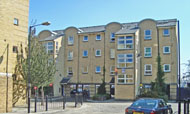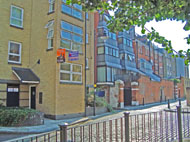Smallpox
In 1882 the Metropolitan Asylums Board (MAB)
moved its smallpox hospital ships - the Atlas, the Endymion and the
Castilia - to new
moorings at Long Reach, an isolated stretch of the
River Thames about 17 miles (27 km) from London Bridge. The
removal of the ships to their new location required the provision
of a River Ambulance Service to ferry patients from central
London. The
following year a pier was constructed at Long Reach for the reception
of smallpox cases from wharves to be built at Rotherhithe, Poplar and Fulham.
In 1883 the General Steam Navigation Co. offered to sell the eastern portion of Brown's Wharf at Blackwall to MAB at the cost of £3500. This included half an acre of land and a river frontage of 100 ft situated off Cold Harbour Street.
The North Wharf Receiving Station opened in 1884, at the start of a smallpox epidemic. It served the central, north and east regions of London. MAB had built a new roadway from Cold Harbour to Bridge Road in order to facilitate easier access for the land ambulances. The road was named Managers Road, after the managers of MAB.
The Receiving Station had an examination room and an isolation ward for patients too sick to be transferred by river ambulance to Long Reach. Other land works were postponed while priority was given to building of the pier, which opened in 1885, just as the epidemic subsided.
As the number of smallpox cases declined, the service was reorganised in 1913. The North Wharf was used only for smallpox patients, while the South Wharf at Rotherhithe dealt with general fever cases.
By 1921 the North Wharf had 9 beds.
In 1930 the LCC took over administrative control from MAB. By this time the river service was rarely used, most patients being transferred by road. The service closed in May 1930 and, by 1933, the steamers had been sold.
The pier was demolished in 1936.
Present status (September 2008)

No. 17 Coldharbour as seen from Managers Street.


No. 17 from the north.
Ayers G 1971 England's First State Hospitals and the MAB 1867-1930. London, Wellcome Institute.
Wilson N 1995/6 Ship Ahoy! Metropolitan Asylums Board River Ambulance Service. Unpublished dissertation filed at the Wellcome Library.
www.bexley.gov.uk
www.dartfordhospitalhistories.org.uk
www.portcities.org.uk
www.workhouses.org.uk
Return to home page